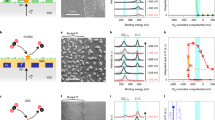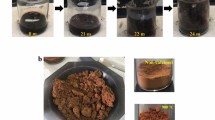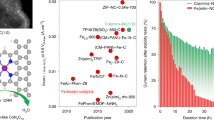Abstract
Fuel cells, and in particular solid-oxide fuel cells (SOFCs), enable high-efficiency conversion of chemical fuels into useful electrical energy and, as such, are expected to play a major role in a sustainable-energy future. A key step in the fuel-cell energy-conversion process is the electro-oxidation of the fuel at the anode. There has been increasing evidence in recent years that the presence of CeO2-based oxides (ceria) in the anodes of SOFCs with oxygen-ion-conducting electrolytes significantly lowers the activation overpotential for hydrogen oxidation. Most of these studies, however, employ porous, composite electrode structures with ill-defined geometry and uncontrolled interfacial properties. Accordingly, the means by which electrocatalysis is enhanced has remained unclear. Here we demonstrate unambiguously, through the use of ceria–metal structures with well-defined geometries and interfaces, that the near-equilibrium H2 oxidation reaction pathway is dominated by electrocatalysis at the oxide/gas interface with minimal contributions from the oxide/metal/gas triple-phase boundaries, even for structures with reaction-site densities approaching those of commercial SOFCs. This insight points towards ceria nanostructuring as a route to enhanced activity, rather than the traditional paradigm of metal-catalyst nanostructuring.
This is a preview of subscription content, access via your institution
Access options
Subscribe to this journal
Receive 12 print issues and online access
$259.00 per year
only $21.58 per issue
Buy this article
- Purchase on Springer Link
- Instant access to full article PDF
Prices may be subject to local taxes which are calculated during checkout





Similar content being viewed by others
References
Jiang, S. P. & Chan, S. H. A review of anode materials development in solid oxide fuel cells. J. Mater. Sci. 39, 4405–4439 (2004).
Sholklapper, T. Z., Kurokawa, H., Jacobson, C. P., Visco, S. J. & De Jonghe, L. C. Nanostructured solid oxide fuel cell electrodes. Nano Lett. 7, 2136–2141 (2007).
Kurokawa, H., Sholklapper, T. Z., Jacobson, C. P., De Jonghe, L. C. & Visco, S. J. Ceria nanocoating for sulfur tolerant Ni-based anodes of solid oxide fuel cells. Electrochem. Solid State 10, B135–B138 (2007).
Gorte, R. J. & Vohs, J. M. Nanostructured anodes for solid oxide fuel cells. Curr. Opin. Colloid Interface 14, 236–244 (2009).
Gross, M. D., Vohs, J. M. & Gorte, R. J. A strategy for achieving high performance with SOFC ceramic anodes. Electrochem. Solid State 10, B65–B69 (2007).
Marina, O. A., Bagger, C., Primdahl, S. & Mogensen, M. A solid oxide fuel cell with a gadolinia-doped ceria anode: Preparation and performance. Solid State Ion. 123, 199–208 (1999).
Tsai, T. & Barnett, S. A. Increased solid-oxide fuel cell power density using interfacial ceria layer. Solid State Ion. 98, 191–196 (1997).
Tsai, T. & Barnett, S. A. Effect of mixed-conducting interfacial layers on solid oxide fuel cell anode performance. J. Electrochem. Soc. 145, 1696–1701 (1998).
Murray, E. P., Tsai, T. & Barnett, S. A. A direct-methane fuel cell with a ceria-based anode. Nature 400, 649–651 (1999).
Park, S., Vohs, J. M. & Gorte, R. J. Direct oxidation of hydrocarbons in solid-oxide fuel cell. Nature 404, 265–267 (2000).
Fu, Q., Weber, A. & Flytzani-Stephanopoulos, M. Nanostructured Au–CeO2 catalysts for low-temperature water-gas shift. Catal. Lett. 77, 87–95 (2001).
Park, J. B. et al. High catalytic activity of Au/CeOx/TiO2(110) controlled by the nature of the mixed-metal oxide at the nanometer level. Proc. Natl Acad. Sci. USA 163, 4975–4980 (2009).
Rodriguez, J. A. et al. Activity of CeOx and TiOx nanoparticles grown on Au(111) in the water–gas-shift reaction. Science 318, 1757–1760 (2007).
Trovarelli, A. Catalytic properties of ceria and CeO2-containing materials. Catal. Rev. Sci. Eng. 38, 439–520 (1996).
Eguchi, K., Setoguchi, T., Inoue, T. & Arai, H. Electrical properties of ceria-based oxides and their application to solid oxide fuel cells. Solid State Ion. 52, 165–172 (1992).
Setoguchi, T., Okamoto, K., Eguchi, K. & Arai, H. Effects of anode material and fuel on anodic reaction of solid oxide fuel cells. J. Electrochem. Soc. 139, 2875–2880 (1992).
Ruiz-Trejo, E. & Maier, J. Electronic transport in single crystals of Gd-doped ceria. J. Electrochem. Soc. 154, 583–587 (2007).
Tuller, H. L. & Nowick, A. S. Small polaron electron-transport in reduced CeO2 single-crystals. J. Phys. Chem. Solids 38, 859–867 (1977).
Lai, W. & Haile, S. M. Impedance spectroscopy as a tool for chemical and electrochemical analysis of mixed conductors: A case study of ceria. J. Am. Ceram. Soc. 88, 2979–2997 (2005).
Lu, C., Worrell, W. L., Vohs, J. M. & Gorte, R. J. A comparison of Cu-ceria-SDC and Au-ceria-SDC composites for SOFC anodes. J. Electrochem. Soc. 150, A1357–A1359 (2003).
Lai, W. Impedance Spectroscopy as a Tool for the Electrochemical Study of Mixed Conducting Ceria. PhD thesis, California Inst. Technology, (2006).
Chueh, W. C., Lai, W. & Haile, S. M. Electrochemical behavior of ceria with selected metal electrodes. Solid State Ion. 179, 1036–1041 (2008).
Ciucci, F., Chueh, W. C., Goodwin, D. G. & Haile, S. M. Surface reaction and transport in mixed conductors with electrochemically-active surfaces: A 2-D numerical study of ceria. Phys. Chem. Chem. Phys. 13, 2121–2135 (2011).
DeCaluwe, S. C. et al. In situ characterization of ceria oxidation states in high-temperature electrochemical cells with ambient pressure XPS. J. Phys. Chem. C 114, 19853–19861 (2010).
Nakamura, T. et al. Determination of the reaction zone in gadolinia-doped ceria anode for solid oxide fuel cell. J. Electrochem. Soc. 155, 1244–1250 (2008).
Nakamura, T. et al. Electrochemical behaviors of mixed conducting oxide anodes for solid oxide fuel cells. J. Electrochem. Soc. 155, 563–569 (2008).
Zhang, C. J. et al. Measuring fundamental properties in operating solid oxide electrochemical cells by using in situ X-ray photoelectron spectroscopy. Nature Mater. 9, 944–949 (2010).
Chen, M., Kim, B. H., Xu, Q., Ahn, B. G. & Huang, D. P. Effect of Ni content on the microstructure and electrochemical properties of Ni-SDC anodes for IT-SOFC. Solid State Ion. 181, 1119–1124 (2010).
McIntosh, S., Vohs, J. M. & Gorte, R. J. Effect of precious-metal dopants on SOFC anodes for direct utilization of hydrocarbons. Electrochem. Solid State 6, A240–A243 (2003).
Uchida, H., Suzuki, S. & Watanabe, M. High performance electrode for medium-temperature solid oxide fuel cells: Mixed conducting ceria-based anode with highly dispersed Ni electrocatalysts. Electrochem. Solid State 6, A174–A177 (2003).
Uchida, H., Osuga, T. & Watanabe, M. High-performance electrode for medium-temperature solid oxide fuel cells: Control of microstructure of ceria-based anodes with highly dispersed ruthenium electrocatalysts. J. Electrochem. Soc. 146, 1677–1682 (1999).
Bessler, W. G. et al. Model anodes and anode models for understanding the mechanism of hydrogen oxidation in solid oxide fuel cells. Phys. Chem. Chem. Phys. 12, 13888–13903 (2010).
Bieberle, A., Meier, L. P. & Gauckler, L. J. The electrochemistry of Ni pattern anodes used as solid oxide fuel cell model electrodes. J. Electrochem. Soc. 148, A646–A656 (2001).
Mizusaki, J., Amano, K., Yamauchi, S. & Fueki, K. Electrode-reaction at Pt,O2(g)/stabilized zirconia interfaces. Part II. Electrochemical measurements & analysis. Solid State Ion. 22, 323–330 (1987).
Mizusaki, J. et al. Kinetic studies of the reaction at the nickel pattern electrode on YSZ in H2–H2O atmospheres. Solid State Ion. 70, 52–58 (1994).
Wilson, J. R. et al. Three-dimensional reconstruction of a solid-oxide fuel-cell anode. Nature Mater. 5, 541–544 (2006).
Brauer, G. & Gradinger, H. Uber heterotype Mischphasen bei Seltenerdoxyden. I. Z. Anorg. Allg. Chem. 276, 209–226 (1954).
Godickemeier, M. & Gauckler, L. J. Engineering of solid oxide fuel cells with ceria-based electrolytes. J. Electrochem. Soc. 145, 414–421 (1998).
Mogensen, M., Sammes, N. M. & Tompsett, G. A. Physical, chemical and electrochemical properties of pure an doped ceria. Solid State Ion. 129, 63–94 (2000).
Chueh, W. C. & Haile, S. M. Electrochemical studies of capacitance in cerium oxide thin films and its relationship to anionic and electronic defect densities. Phys. Chem. Chem. Phys. 11, 8144–8148 (2009).
Kobayashi, T., Wang, S., Dokiya, M., Tagawa, H. & Hashimoto, T. Oxygen nonstoichiometry of Ce1−ySmyO2−0.5y−x (y=0.1, 0.2). Solid State Ion. 126, 349–357 (1999).
Chueh, W. C. Electrochemical and Thermochemical Behavior of C e O2−x. PhD thesis, California Inst. Technology (2011).
Huang, Y-H., Dass, R. I., Xing, Z-L. & Goodenough, J. B. Double perovskite as anode materials for solid-oxide fuel cells. Science 312, 254–257 (2006).
Tao, S. & Irvine, J. T. S. A redox-stable efficient anode for solid-oxide fuel cells. Nature Mater. 2, 320–323 (2003).
Zha, S., Rauch, W. & Liu, M. Ni–Ce0.9Gd0.1O1.95 anode for GDC electrolyte-based low-temperature SOFCs. Solid State Ion. 166, 241–250 (2004).
Muecke, U. P. et al. Electrochemical performance of nanocrystalline nickel/gadolinia-doped ceria thin film anodes for solid oxide fuel cells. Solid State Ion. 178, 1762–1768 (2008).
Primdahl, S. & Mogensen, M. Mixed conductor anodes: Ni as electrocatalyst for hydrogen conversion. Solid State Ion. 152–153, 597–608 (2002).
Acknowledgements
This work was supported in part by the Stanford Global Climate & Energy Project and by the National Science Foundation under contract number DMR-0604004. Additional support was provided by the NSF through the Caltech Center for the Science and Engineering of Materials, a Materials Research Science and Engineering Center (DMR-052056). W.C.C. was also supported by an appointment to the Sandia National Laboratories Truman Fellowship in National Security Science and Engineering, sponsored by Sandia Corporation (a wholly owned subsidiary of Lockheed Martin Corporation) as Operator of Sandia National Laboratories under its US Department of Energy Contract No. DE-AC04-94AL85000. The authors also acknowledge C. M. Garland and D. A. Boyd of Caltech and M. W. Clift of Sandia for their assistance with analytical measurements, K. L. Gu of Caltech for sample fabrication, F. Ciucci of University of Heidelberg for numerical simulations and D. G. Goodwin and E. C. Brown of Caltech and F. El Gabaly and A. H. McDaniel of Sandia for valuable discussions. The Evans Analytical Group carried out focused ion beam imaging, and for that effort the authors are particularly grateful to H. Deng.
Author information
Authors and Affiliations
Contributions
W.C.C. designed the experiment, fabricated samples and carried out analytical and electrochemical characterizations. Y.H. developed the fabrication methodology for dense electrochemical cells and carried out the sample preparations and characterizations. W.J. fabricated and characterized porous electrochemical cells. S.M.H. guided and supervised the work.
Corresponding author
Ethics declarations
Competing interests
The authors declare no competing financial interests.
Supplementary information
Supplementary Information
Supplementary Information (PDF 1606 kb)
Rights and permissions
About this article
Cite this article
Chueh, W., Hao, Y., Jung, W. et al. High electrochemical activity of the oxide phase in model ceria–Pt and ceria–Ni composite anodes. Nature Mater 11, 155–161 (2012). https://doi.org/10.1038/nmat3184
Received:
Accepted:
Published:
Issue Date:
DOI: https://doi.org/10.1038/nmat3184
This article is cited by
-
Mechanically driven assembly of biomimetic 2D-material microtextures with bioinspired multifunctionality
Nano Research (2024)
-
Facile strategy to construct porous CuO/CeO2 nanospheres with enhanced catalytic activity toward CO catalytic oxidation at low temperature
Applied Nanoscience (2023)
-
Simulation and Analysis of Atomization Performance of a Venturi Jet Pyrolysis Reactor
Metallurgical and Materials Transactions B (2023)
-
Quantifying the Relationship Between Microstructure and Performance in Gadolinium-Doped Ceria Infiltrated Ni/YSZ Symmetric Cells
JOM (2022)
-
Colossal oxygen vacancy formation at a fluorite-bixbyite interface
Nature Communications (2020)



